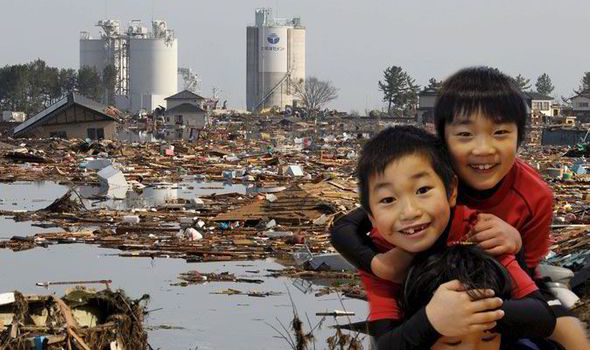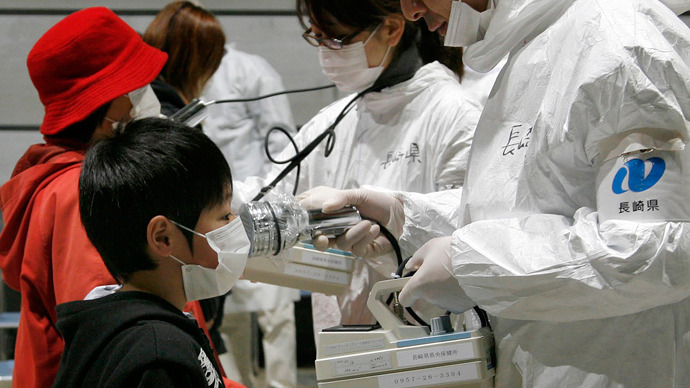map made available by Nuclear Darkness:

*This map provides for some some safe zones that may have lowered radiation levels. Although with nuclear fallout there is no place that is completely safe.
******************************************************************************************
The Medical and Ecological Consequences of the Fukushima Nuclear Accident, Day 1
March 11, 2013
Click on a bolded link below to jump to that section of the program.
Introductions
Moderator: Donald Louria, MD, Chairman Emeritus, Department of Preventive Medicine and Community Health, University of Medicine and Dentistry, New Jersey
Session One: DESCRIPTION AND ANALYSIS OF ACCIDENT
Former Prime Minister of Japan, Naoto Kan (videotape)
Opening Address
Hiroaki Koide, Master of Nuclear Engineering, Kyoto University Research Reactor Institute (KURRI)
Specialist of Radiation Safety and Control
Arnie Gundersen, Nuclear Engineer, Fairewinds Associates
What Did They Know and When Did They Know it?
David Lochbaum, Union of Concerned Scientists
Another Unsurprising Surprise
Hisako Sakiyama, Member of Fukushima Nuclear Accident Independent Investigation Commission
Risk Assessment of Low Dose Radiation in Japan: What Became Clear in the Diet Fukushima Investigation Committee
Akio Matsumura, Founder of the Global Forum of Spiritual and Parliamentary Leaders
What Did the World Learn from the Fukushima Accident?
Session Two: THE MEDICAL AND ECOLOGICAL CONSEQUENCES
Steven Starr, Clinical Laboratory Science Program, University of Missouri
The Implications of Massive Radiation Contamination of Japan with Radioactive Cesium
Timothy Mousseau, Department of Biological Sciences, University South Carolina
Chernobyl, Fukushima and Other Hot Places: Biological Implications
Ken Buesseler, Marine Scientist Woods Hole Oceanographic Institute
Fukushima Ocean Impacts
David Brenner, Center for Radiological Research, College of Physicians and Surgeons
Columbia University
Living with Uncertainty About Low Dose Radiation Risks
*********************************
March 12, 2013
Click on a bolded link below to jump to that section of the program.
Session Three:
THE MEDICAL CONSEQUENCES OF BOTH THE CHERNOBYL AND FUKUSHIMA CRISES AS THEY RELATE TO NORTH AMERICA
Session Chair: Andrew Kanter, Physicians for Social Responsibility.
Alexey Yablokov, Russian Academy of Sciences
Lessons from Chernobyl
Wladimir Wertelecki, Former Chair of the Department of Medical Genetics University South Alabama
Congenital Malformations in Rivne Polossia and the Chernobyl Accident
Ian Fairlie, Radiation Biologist and Independent Consultant
The Nuclear Disaster at Fukushima: Nuclear Source Terms, Initial Health Effects
Steve Wing, Gillings School of Public Health, University North Carolina
Epidemiological Studies of Radiation Releases from Nuclear Facilities: Lessons Past and Present
Joe Mangano, Radiation and Public Health Project
Post Fukushima Increases in Newborn Hypothyroidism on the West Coast of USA
Robert Alvarez, Institute for Policy Studies
Management of Spent Fuel Pools and Radioactive Waste
Cindy Folkers, Beyond Nuclear
Post-Fukushima Food Monitoring in the US
Mary Olson
Nuclear Information and Resource Services, Gender Matters in the Atomic Age
Kevin Kamps, Beyond Nuclear
Seventy Years of Radioactive Risks in Japan and America
David Freeman, Former Chair. Tennessee Valley Authority
My Experience with Nuclear Power
Herbert Abrams, Stanford University School of Medicine
The Hazards of Low Level Ionizing Radiation: Controversy and Evidence
******************************************************************************************
Two years after the Fukushima nuclear disaster is Japan facing a cancer time bomb?
TWO years after the Fukushima nuclear disaster local children are showing signs of cancer, prompting cries of a cover-up.
Published: Wed, March 27, 2013
 LEGACY: No one knows how the Fukushima disaster will affect the health of the area’s children
LEGACY: No one knows how the Fukushima disaster will affect the health of the area’s childrenIN the shadow of the Fukushima nuclear power station life appears to have returned to normal. A farmer tends his cows and goes about his daily routine as dogs play round his feet. Signs of spring are everywhere and birds sing. But take a closer look and it’s all a sham.
The rice fields are overgrown with weeds as tall as a man. The rest of this village, near the scene of the world’s worst nuclear disaster since Chernobyl, is deserted. Washing still hanging on lines hints at the panic which engulfed this region of Japan.
The farmer is among a handful of people who defied an order by the authorities to evacuate. Beef from this area was once prized for its taste and quality but his cows, which graze within sight of the chimneys of the plant, should have been slaughtered and are now worthless.
Two years after an earthquake and tsunami caused a meltdown in the reactors at Fukushima, releasing clouds of radiation, the world has moved on.
Officially the mass evacuation was a success and the prompt action of a heroic band of workers at the crippled plant averted a nuclear catastrophe. No one has so far died as a result of radiation from Fukushima, insist the authorities. However there are growing concerns that the full scale of the disaster has yet to be seen. There are claims of complacency and a cover-up. It’s not the Japanese way to stage protests but there has been a series of anti-nuclear rallies in Tokyo, 160 miles south.
Most worrying are the results of tests carried out on more than 130,000 children who lived around Fukushima. More than 40 per cent have the early signs of thyroid cancer, while other forms of the disease may not become apparent for a decade.
While it’s true that people living very close by were evacuated within the first few days, damage may already have been done to their health. Many more, living up to 25 miles away, were not moved away until six weeks after the radiation escaped.
It’s also feared that the food chain has been contaminated. Radioactive material has been detected in a range of produce, including spinach, tea leaves, milk and beef, up to 200 miles distant. Fish caught near the plant this month were more than 5,000 times over safe radiation limits, according to Japan’s state broadcaster NHK.
Then there’s the daily risk of more radiation escaping from the smouldering plant, which is still not fully stable. It’s being cooled with vast amounts of water but workers are running out of tanks in which to store the contaminated liquid once it has done its job.
*****************************************************************************************
Almost third of US West Coast newborns hit with thyroid problems after Fukushima nuclear disaster
Published time: April 03, 2013 19:56
Edited time: April 04, 2013 19:43

Researchers have discovered that the Fukushima nuclear disaster has had far-reaching health effects more drastic than previously thought: young children born on the US West Coast are 28 percent more likely to develop congenital hyperthyroidism.
In examining post-Fukushima conditions along the West Coast, researchers found American-born children to be developing similar conditions that some Europeans acquired after the 1986 meltdown of the Chernobyl Nuclear Power Plant.
“Fukushima fallout appeared to affect all areas of the US, and was especially large in some, mostly in the western part of the nation,” researchers from the New York-based Radiation and Health Project wrote in a study published by the Open Journal of Pediatrics.
Children born after the 2011 meltdown of Japan’s Fukushima Nuclear Power Plant are at high risk of acquiring congenital hyperthyroidism if they were in the line of fire for radioactive isotopes. Researchers studied concentration levels of radioiodine isotopes (I-131) and congenital hypothyroid cases to make the association.
Just a few days after the meltdown, I-131 concentration levels in California, Hawaii, Alaska, Oregon and Washington were up to 211 times above the normal level, according to the study. At the same time, the number of congenital hypothyroid cases skyrocketed, increasing by an average of 16 percent from March 17 to Dec. 31, 2011. And between March 17 and June 30, shortly after the meltdown, newly born children experienced a 28 percent greater risk of acquiring hyperthyroidism.
*****************************************************************************************
Related articles
- WHO faulted on Fukushima radiation (bigpondnews.com)
- WHO faulted on Fukushima radiation – Sky News Australia (skynews.com.au)
- Almost third of US West Coast newborns hit with thyroid problems after Fukushima nuclear disaster (seeker401.wordpress.com)
- Two Years On, Fukushima Raises Many Questions, Provides One Clear Answer (nonukesaction.wordpress.com)
- ZeroHedge: Fukushima: Massive Leaks Continuing On a Daily Basis … For Years On End (silveristhenew.com)
- Conference Highlights Fukushima Consequences (activistpost.com)
- Videos now officially released for the Medical and Ecological Consequences of the Fukushima Nuclear Accident – 11 March 2013 – New York (nuclear-news.net)
- Fukushima fallout – thyroid damage in US children (nyrnaturalnews.com)
- Fukushima: Massive Leaks Continuing On a Daily Basis … For Years On End (washingtonsblog.com)
- Gundersen: We’re getting reports from Japan of deformed children, troubled pregnancies after Fukushima (AUDIO) and Dr Helen Caldicott’s NY Symposium on 2nd Anniversary of Fukushima Nuclear Catastrophe (ascendingstarseed.wordpress.com)






















